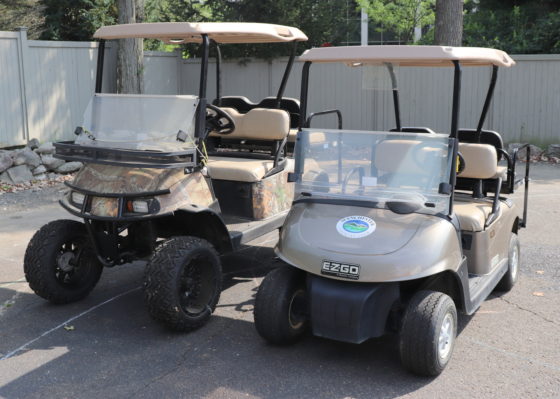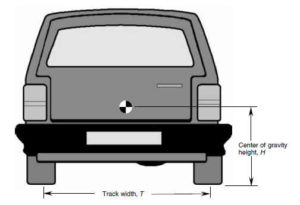What are lift kits?
There is a growing, and problematic, prevalence of “lifted” golf carts in use around the U.S. These vehicles are typically modified with “lift kits” and oversized tires and then sold at golf cart dealerships. Lift kits include replacement suspension components that significantly increase the height of the vehicle to allow for the installation of larger wheels and tires. They are typically manufactured and sold by aftermarket golf car part suppliers like Madjax, RedHawk and Jake’s and are often combined with other modifications such as rear facing seat kits.

Effect of lift kits on rollover
The primary hazard associated with lift kits is a greatly increased probability of rollover. Lift kits are usually marketed with names that indicate the lift kit size (typically 4” to 6”) but which raise the vehicle’s center of gravity by more than the advertized lift dimension when the additional height increase caused by the larger tires is taken into account. As a result, a 6” lift kit is likely to raise a vehicle’s center of gravity by approximately 8” or more, which is quite drastic when one considers that a non-lifted golf cart will typically have a center of gravity height on the order of 15”. Such an increase in center of gravity height results in a significant reduction in rollover resistance. As a result, a lifted vehicle is much more likely to roll over than a non-lifted vehicle, all other things being equal. This problem is often compounded by the fact that the addition of larger tires, in the absence of compensating adjustments, also increases the vehicle’s top speed.
The primary factors that affect a vehicle’s rollover propensity are its track width and center of gravity height. To a first approximation, the rollover resistance can be computed using the Static Stability Factor (SSF) which is described by the equation SSF = (track width) / (2 x height). In keeping with this relationship, the lateral acceleration necessary to initiate a rollover is not dependent upon the overall weight of the vehicle and instead depends only upon the location of its center of gravity and the effective track width.

The Static Stability Factor (SSF) provides a reliable basis for comparison of the relative stability and rollover propensity characteristics of different vehicles. To understand the relative rollover stability of a typical lifted golf cart the accompanying figure shows the Static Stability Factors (SSF) for various types of vehicles, including some lifted golf carts. These data indicate that lifted golf carts are unusually unstable with a SSF well below that of any other class of passenger vehicles, including off road vehicles such as OEM golf carts and Recreational Off-road Vehicles (ROVs) like the Yamaha Rhino, which was itself the subject of a rollover related safety recall. Therefore, the addition of a lift kit to a golf cart is likely to take a vehicle that already possesses a low SSF and reduce that SSF below that of any road-going vehicle or any Recreational Off-Highway vehicle that has been studied. The SSF of lifted golf carts can be so low as to constitute an unreasonable rollover hazard that drivers do not appreciate. Furthermore, the negative effect of the lift kit on the vehicle’s stability will be exacerbated by the increase in the maximum speed created by the larger tire size.

While some golf car, PTV and utility vehicle standards such as ANSI Z130.1, ANSI Z135 and SAE J2258 do specify some basic static stability criteria, the passing values are so easily reached that even a vehicle that can rollover during fairly routine maneuvers will satisfy the standard. These lateral stability passing values are so lenient that a vehicle that just barely passes those tests will be extremely unstable and susceptible to rollover. Furthermore, some of these standards have undergone significant changes since they were first adopted which have made the requirements much less stringent than they were originally, despite no scientific justification for those relaxed standards.
Lift kit risk utility analysis
The most commonly cited benefit of a lift kit with oversized tires is that it enhances the aesthetics of the vehicle. Some suppliers also claim that the additional ground clearance of a lifted vehicle provides enhanced off-road performance, though OEM golf cars are already designed to operate off-road and lifted golf carts are commonly driven on local streets where enhanced ground clearance is not necessary. As a result the utility of a lift kit is quite limited. On the other hand, the risk associated with adding a lift kit is extreme. Lift kits unnecessarily increase the likelihood of a rollover with the potential to cause catastrophic and even fatal injuries. If superior off-road performance is required, other types of vehicles such as ROVs, which come standard with rollover protection and seat belts, are available. In practice, the true utility of lift kits appears to be as a gimmick to make used golf carts easier to sell, with little regard for customer safety.

What should be done?
If lift kits must be offered, the stability of the resting vehicle should be increased by lowering the center of gravity height (i.e. reducing the amount of lift) and widening the track width to compensate for the raised center of gravity. Given the severe reduction in rollover resistance caused by lift kits, and the commonly stated rationale that lift kits improve off-road performance, lift kits and lifted golf carts should be provided with warnings that warn users against driving on pavement, where rollover may be more likely due to high tire-road friction. Guarding occupants against ejection and rollover injuries could also be accomplished with occupant protection features such as seat belts, ROllover Protective Structures (ROPS, i.e. roll bars) and/or other structures such as doors, which are commonly provided with other off-road vehicles such as ROVs. Finally, many existing OEM golf cart on-product warnings do not include any information about lift kits or other modifications, despite the widely known practice of adding lift kits to golf carts. When a golf car’s original lease with a golf course is over, the vehicle will very often be sold to a used car dealer who may modify the vehicle before selling it to the end user. Therefore, golf cars and the aftermarket accessories that are used to modify them, should be provided with warnings about the hazards of such modifications and their effects on vehicle handling.
Summary
While customers may like the way a lift kit makes a golf cart look, and dealers may find it easier to sell lifted vehicles, the risks of operating lifted golf carts, as they are currently designed, far outweigh the utility of having a golf cart that looks cool and is easier to sell. This is particularly a problem when the customers who are buying the vehicle may not even know they are buying a modified product and are not given sufficient warning about the greatly reduced stability. Lift kits as currently designed, like the discontinued three-wheel golf carts of the past, are simply too dangerous to justify their use, particularly when the consequences of a rollover can be so severe and the benefits are so superficial.